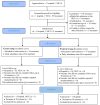The Effect of Incubator Cover on Newborn Vital Signs: The Design of Repeated Measurements in Two Separate Groups with No Control Group
- PMID: 37508721
- PMCID: PMC10378478
- DOI: 10.3390/children10071224
The Effect of Incubator Cover on Newborn Vital Signs: The Design of Repeated Measurements in Two Separate Groups with No Control Group
Abstract
(1) Background: During their stays in neonatal intensive care units (NICU), newborns are exposed to many stimuli that disrupt their physiological indicators. The aim of this study was to investigate the impact of the light-dark cycle created with and without an incubator cover on the vital signs of term and preterm newborns. (2) Methods: A repeated measures design was used in the study utilizing two separate groups, without a control group. The study included 91 neonates hospitalized in a NICU (44 term and 47 preterm). With and without an incubator cover, the newborns' vital signs (heart rate (HR), respiratory rate (RR), oxygen saturation (SpO2), and body temperature (BT)) were measured. Three separate measurements were taken. (3) Results: The mean age of the newborns was 37.0 weeks. There was no significant difference between the HR and RR medians of the term and preterms in the incubator undraped and clad measurements (p > 0.05). At the first measurement, the SpO2 medians of the incubator-covered term and preterms were significantly higher than those of the incubator-covered term and preterms (p = 0.001). (4) Conclusions: The vital signs of the neonates demonstrated variable responses in the measurements when their incubators were covered vs. when they were not covered. However, more research on the effect of the light-dark cycle on their vital signs is required.
Keywords: incubator cover; light-dark cycle; preterm; term; vital signs.
Conflict of interest statement
The authors declare no conflict of interest.
Figures







Similar articles
-
Remote sensing of vital signs by medical radar time-series signal using cardiac peak extraction and adaptive peak detection algorithm: Performance validation on healthy adults and application to neonatal monitoring at an NICU.Comput Methods Programs Biomed. 2022 Nov;226:107163. doi: 10.1016/j.cmpb.2022.107163. Epub 2022 Sep 27. Comput Methods Programs Biomed. 2022. PMID: 36191355
-
Electromagnetic fields produced by incubators influence heart rate variability in newborns.Arch Dis Child Fetal Neonatal Ed. 2008 Jul;93(4):F298-301. doi: 10.1136/adc.2007.132738. Epub 2008 May 1. Arch Dis Child Fetal Neonatal Ed. 2008. PMID: 18450804
-
Effects of hammock positioning in behavioral status, vital signs, and pain in preterms: a case series study.Braz J Phys Ther. 2018 Jul-Aug;22(4):304-309. doi: 10.1016/j.bjpt.2018.03.002. Epub 2018 Mar 15. Braz J Phys Ther. 2018. PMID: 29598896 Free PMC article.
-
Skin-to-skin care in preterm infants receiving respiratory support does not lead to physiological instability.Arch Dis Child Fetal Neonatal Ed. 2017 Jul;102(4):F339-F344. doi: 10.1136/archdischild-2016-311752. Epub 2017 Jan 17. Arch Dis Child Fetal Neonatal Ed. 2017. PMID: 28096239 Clinical Trial.
-
The infant incubator in the neonatal intensive care unit: unresolved issues and future developments.J Perinat Med. 2009;37(6):587-98. doi: 10.1515/JPM.2009.109. J Perinat Med. 2009. PMID: 19591569 Review.
References
LinkOut - more resources
Full Text Sources

